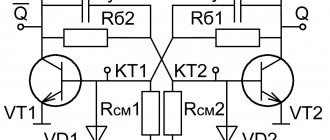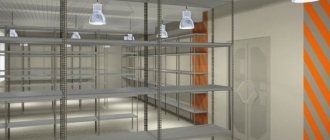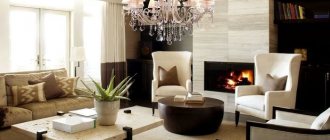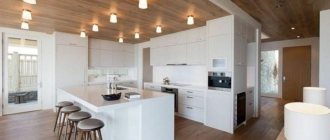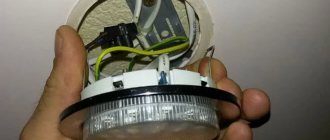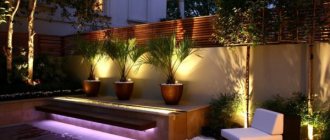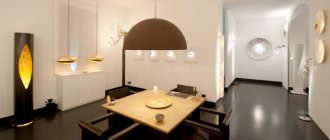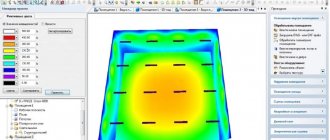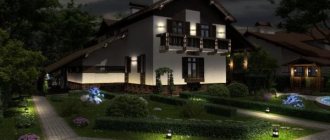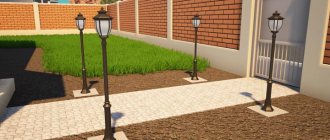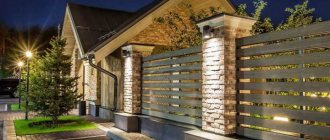Spotlights are the most popular devices for lighting suspended ceilings. They became popular due to their low cost and ease of installation. They are installed in any room both as primary and additional lighting, arranged in different orders and combined with other light sources. Let us consider in detail what types of lamps there are and how to choose the right light bulbs so as not to spoil the stretch ceiling.
What is a spot
A spot is a lamp for organizing directional or diffuse lighting. The name comes from the English word “spot”, which translates as “point”. In fact, these are point devices emitting soft, unobtrusive streams.
Such lamps are equipped with special brackets on hinges. With the help of these elements it is easy to change the direction of light flows. Some types of spots can even be scrolled around an axis and fixed in any position.
The photo shows what the spots look like. These are only two types of devices. There are many more variations in the range.
Wall spots with LED lamps
Ceiling spots with glass shades
Design Features
Today, the arrangement of the ceiling is directly related to the installation of tension fabric. Such designs are not able to withstand the weight of ordinary chandeliers, which is why special lamps for the ceiling were created. Built-in appliances allow you to implement any design solutions, without forgetting such important qualities as ergonomics and practicality.
The design of the equipment is simple - a lamp, a housing and a fastening element. The body includes a cartridge made of heat-resistant plastic or porcelain, a reflector that prevents light from entering under or onto the tension fabric, and a diffuser.
Pros and cons: advantages and disadvantages of spots
Directional lamps are an excellent solution if you need to highlight a certain area of a room or local area with light. Let's discuss the advantages of using spots:
- Organization of local lighting. Using spots, you can highlight individual areas of the room. For example, a relaxation area, a bar counter, a work space. This is a way to create comfortable conditions without using primary lighting sources.
- Zoning of space. Spotlights will help to visually delimit the room into separate areas. This technique is especially often used in combined rooms. For example, kitchens and living rooms.
- Organization of decorative lighting. Spots are an ideal element in a creative lighting scenario. The devices do not look too pretentious, so they will fit even into strict minimalist interiors.
- Creating basic lighting in compact spaces. In small rooms, massive chandeliers often look bulky. Spots are a worthy alternative. If you choose the optimal number of elements, there will be enough light.
- Possibility to group devices in different ways. There are several layouts of spots on the ceiling and walls. You can come up with your own version. The main thing is to correctly calculate the number of lamps.
The main advantage of spots is the simple installation process. You will be able to handle the installation even if you have never interacted with lighting equipment before.
Spots are compatible with various types of lamps: halogen, fluorescent, LED. There will be no difficulties when replacing the light element. Simply unscrew the lampshade and insert a new lamp.
The devices have no objective disadvantages. If you choose the right number of elements and design, then with the help of spots you can implement any lighting scheme.
Ceiling round spots
Important! A ceiling with spots visually appears higher. If you have a small room, take note of this trick.
Types of spots
Spot lamp is the general name for a group of lamps. Devices are classified into four types according to design and installation method. Options:
- Built-in ceiling. Lamps are integrated into holes in the suspended ceiling. The housing with a rotating bracket is fixed under the canvas so that only the light element is visible on the surface. Before connecting to the power supply, the devices are secured using spring clips. Such spots can be located either in a group or in a chaotic order.
- Large ceilings. Lamps that are installed on cable strings. The metal base must be attached to the ceiling, after which the spots must be placed. One such cable can support the weight of 4-8 devices, so the design is suitable for organizing basic lighting.
- Invoices. Devices for fixing to the wall or ceiling. The main feature is a rotating mechanism that allows you to illuminate the room at an angle of up to 360 degrees. It is better to fix such lamps on plasterboard panels or concrete surfaces. The devices are also suitable for suspended ceilings. The only point is that overhead spots have a fairly massive base, so it will be difficult to hide it under the canvas.
- Point wall. Round cutlery with miniature base. Suitable for placement on walls and furniture facades. An excellent option for decorative lighting in the kitchen, nursery and bedroom.
Regardless of the design, the spots have the same functionality. Therefore, you can choose a model based on the interior features of the rooms.
Built-in spots in the interior
Ceiling spots in the interior
Overhead spots in the interior
Wall spot in the interior
Technical limitations of suspended ceilings
The main problem with this type of finishing is that the PVC film that is used as a canvas cannot withstand high temperatures. And for some lighting fixtures, the housing becomes very hot and can melt the adjacent area of the canvas.
The second limitation is that it is impossible to attach a lamp or other interior item to suspended ceilings. Therefore, additional supporting structures are used - mortgages. They are special plastic platforms on metal hangers, which are attached to the concrete floor and located behind the canvas. The lower part of the structure is level with the decorative coating.
In the place where it is planned to install the lamp, plastic protectors - thermal rings - are pre-glued to the stretched fabric. They perform two functions: they additionally protect the PVC film from overheating and prevent the edges of the hole from stretching.
How does a spot differ from a sconce?
Many people confuse wall spots and sconces. Some models are really visually similar. And they are most often placed in the same place - near the bed or sofa.
However, the products have a significant difference - the method of inclusion. The sconces are equipped with their own switches in the form of a cord or a button on the body. Spots do not have this option. The devices are activated using a general switch or control panel if the house has a “smart light” system.
And one more difference. It is advisable to use spots for organizing general lighting, sconces - not. Devices from the second category are usually used to highlight a small area in a room with light.
Adjustment type
All of the above types of spotlights can also differ in the type of adjustment. Depending on this, spotlights are:
- non-rotating – illuminate part of the room, but the direction of the light flow cannot be adjusted;
- rotating - allow you to adjust the angle of incidence of light and its direction;
- rotating and retractable spotlights are used to change lighting zones.
In terms of functional features, spotlights can also vary significantly. Modern models are equipped with remote control, have a wider angle of light incidence, protection against dust and moisture, and other functions.
Characteristics of spots
Before choosing devices, it is important to analyze the operational parameters of the products and design features. Let's look at the types of models based on power, size and mounting methods.
Lamp power
To select the power and brightness of the lamp, it is necessary to calculate the coefficient of the norm of illumination in the room. A universal option is LED spots. There are models with built-in dimmers, with which you can easily adjust the saturation of light fluxes. Such devices are suitable as sources of main lighting.
Important! If you choose spots with low power, purchase several devices. One source produces too dim light/
Size
By size, spots are divided into small, medium and large. The third group includes overhead lamps and specimens that are mounted on a rod.
Options for lampshade dimensions for built-in devices: 60, 65, 70, 75, 80, 85 mm. There are no strict parameters for large devices - it all depends on the type and design of the model.
Mounting type
How aesthetically pleasing the structure will look depends on the way the spotlights are fixed. Two mounting options:
- On the barbell. With this method, flexible metal strings are used to attach spots. This option is suitable for fixing devices on the wall and ceiling. The bases come in different diameters, but thin round cables are especially popular. Please note that the structure will be visible, so it is important to choose the right mount.
- On brackets. Lamps on a flexible base are suitable for installation on any plane: ceilings, walls, furniture facades. The fastening structure can be left in plain sight or hidden under the tension fabric.
There are also combined spots available for sale. They can be mounted either on brackets or on a rod.
Spot with bracket mounting
Spot with rod mount
Which light bulbs are suitable for suspended ceilings
Some types of lamps become very hot during operation and are therefore not recommended for use with stretch fabrics. It is also important to consider the color temperature and power of lighting fixtures. Let's consider each parameter in detail.
Types of lamps
According to the type of lighting element there are:
- halogen;
- luminescent (energy saving);
- LED;
- incandescent lamps.
For suspended ceilings, fluorescent and diode ceilings are recommended, since they do not heat the canvas. Other reasons why these varieties are more convenient are low power consumption and long service life. Incandescent and halogen lamps can also be used, but with a power of up to 40-60 watts. It is better to mount, especially the first ones, only in overhead lamps, and so that the flow is directed strictly downward. Otherwise, the canvas will overheat and melt. It is better to choose incandescent lamps with mirror coating in order to obtain a directed light flux.
Halogen ones differ in that there is another small lamp inside the bulb. They can also be capsule or finger-type, and are a miniature flask with two terminals. These models are installed in closed luminaires, in particular G9, G4, G5.3. It should be taken into account that halogen lamps also heat up the socket.
Luminescent ones are effective only with constant operation. When switched on and off frequently, they consume relatively a lot of energy, which is spent on heating. Another drawback is that at first they turn on at half power and only then flare up to full power.
LED lamps for suspended PVC ceilings are considered the best. They consume the least amount of electricity and last longer than incandescent lamps.
But the diodes also heat up, which shortens their service life. To remove heat, high-quality products have an aluminum radiator grille through which cooling is carried out. Recently, models have appeared in which the cooling component is composite; aluminum and plastic are used for its manufacture. Manufacturers claim that it removes heat in the same way as powerful monometallic counterparts. However, you need to choose only well-known brands.
Colorful temperature
The luminous flux varies. You can find out the nature of the radiation by looking at the markings on the packaging. Thus, the marking from 1800 to 3800 Kelvin means that the light is emitted in the warm range. It relaxes, makes the space cozy and is more suitable for a residential home. 4000–5000 K is neutral, above 5000 K is cold lighting. It tones, so it is suitable for a workplace - for example, a study or office.
Required lamp power and lighting standards
There are average indicators for an apartment per 1 m² based on an incandescent lamp:
- bedroom - 15 W;
- children's - 60 W;
- living room, bathroom, hallway - 22 W;
- kitchen - 26 W.
Correspondence table for different types of lamps (W):
| Incandescent | Energy saving | LED |
| 25 | 4 | 3 |
| 40 | 9 | 5 |
| 60 | 13 | 8 |
| 100 | 20 | 14 |
| 150 | 30 | 22 |
A formula has also been developed to determine the number of lighting fixtures (N):
N=(SxW)/P , where:
- S is the area of the room;
- W—lighting standard;
- P is the power of one element.
When developing a placement scheme, it is necessary to take into account that the lamps can be installed at a distance of at least 30 cm from each other and at least 20 cm from the wall.
Read more: How many lamps are needed per square meter of stretch ceiling
Design of spotlights
Designers are actively experimenting with the appearance of lamps. Main design trends:
- Modern: body made of glass, chromed metal, plastic. The design is dominated by bold geometric shapes and bright colors. Decor: prints, spraying, gradient. A new trend is spots in a chrome-plated body of an unexpected shape.
- Classic: body made of copper, bronze, tempered glass. Decor: gold or silver plating, patina, patterns. The design is dominated by soft regular shapes and calm, neutral shades.
This is a photo of spots in different design options. Look how harmoniously they fit into modern interiors.
Spots in a classic design
Wall spots in a chrome casing
Wall spots in a bright glass case
Important! Vintage spot models are available for sale. They will go perfectly with fashionable retro wiring.
Option: 4 Arrangement of spotlights diagonally and in corners
This method of arrangement can be used symmetrically or as an opportunity to illuminate one separate zone, which has a decorative character. A similar scheme is suitable for almost any room: kitchen, bathroom, living room, small bedroom , any room of irregular geometric shape. It is important to correctly calculate the proportions of the structure so that it does not “get lost” in a large room or “absorb” a too small one.
This is just a small list of the most common installation schemes for spotlights. For any room, it is advisable to prepare a unique, individual project that would combine different types of lamps into one unique whole, perfect in its functionality.
Chapter 5:
Scope of spots: lighting scenarios
The choice of spot depends on the functional purpose of the lamps. There are models for indoor and outdoor lighting. Let's analyze all the classifications and scenario options.
Main lighting
A system with movable lamps is suitable for organizing basic lighting. You can combine elements with familiar light sources. For example, chandeliers or pendant lamps.
Follow the principle of multi-level lighting. Make sure that light flows into every area of the room. If some corners seem dark, add at least one spot there.
Important! Before installing lamps, study the types of lighting and select the layout of the devices in advance.
Background lighting
You can organize background lighting using rays of light directed at the surface. Rotate the spots so that they “look” at the walls from different angles. The result will be soft, diffused flows that won’t strain your eyes.
Warm yellowish lamps are suitable for this scenario. In the office or kitchen, you can use lamps with light of a neutral or cool shade of low intensity.
Accent lighting
To implement the scenario, spots on a metal rod are suitable. The structure must be placed on the ceiling in the area that you want to highlight. If necessary, the lamps can be moved along the string and the angles of inclination can be changed.
Wall-mounted lamp models are suitable for accenting interior items. For example, you can place devices above paintings or posters.
Street lighting
You can place spots on the facades of the building or build them into steps. Spotlights will be an excellent addition to lanterns, garden lamps and floodlights.
Proper illumination of the facade of the house will add comfort and create a feeling of security. You can additionally organize lighting for the gazebo and veranda. Don't be afraid to experiment - combine different types of devices. Spots look great in combination with any light sources.
Spots for lighting the facade of a house
Option: 3 Arrangement of spotlights in the form of waves and a semicircle
Often these are multi-level ceilings, the designs of which require careful study. These are, of course, real works of art, which, moreover, must be made at a high technical level from high-quality materials. Such schemes are perfect for rooms - studios with open space, zoning a place for eating or relaxing. “Waves” from spotlights also look good in the kitchen.
Spot price
The price of lamps depends on the model, manufacturer, functional characteristics, and design. The most budget models cost 300-500 rubles.
Original devices for long-term use can be purchased for 2,000-8,000 rubles. Examples of models at reasonable prices: Lucide Loco rotary lamp, Novotech Pipe, De Markt Cruz.
There are more expensive products. Designer models for exclusive interiors will cost 10,000 rubles and more.
buybuy
Swivel spot Lucide Loco
buybuy
Novotech Pipe overhead spot
buybuy
Built-in spot De Markt Cruz
Spot selection criteria
Let's move on to the selection rules. Some tips from designers:
- When purchasing spots, consider how much area needs to be illuminated. Based on this, choose the power and number of devices. If you need primary lighting sources, give preference to products with approximately the same characteristics.
- Do not forget about the compatibility of the style of the lamp with other furnishings. If you are afraid of making a mistake, choose specimens of the correct shape in a neutral color scheme.
- Decide on the shade of light. Neutral or warm currents are more suitable for the bedroom, living room, nursery and hallway. For the kitchen and office, you can choose cold ones.
- Think in advance where to install the spots. Based on this, decide on the type of fastening.
- If you choose spotlights for the bathroom, pay attention to models with a waterproof body. They withstand changes in temperature and humidity well.
- Please note that suspended ceiling fabric is incompatible with lamps that heat up. It's better to stick with LED models.
You can combine several spot models in one room. Make sure that the products are “in tune” with each other. Such ensembles are an interesting zoning option.
Protection classes of lighting devices
To illuminate rooms with high humidity, devices with enhanced protection are used. The protection class is indicated by the letters IP and two numbers.
The first indicates the degree of protection against the penetration of solid objects and dust into the housing. There are 7 classes: from zero, when the device is not protected, to sixth, in which dust and foreign objects are guaranteed not to get inside the case.
The second number indicates the level of protection of the housing from liquids. At class zero there is no protection; at the maximum class nine, the device operates for a long time when deeply immersed in liquid.
For baths and saunas, devices with a degree of protection of IP44 are suitable. The first “four” means that the device is protected from solid objects larger than 1 mm, the second guarantees protection from splashes flying in all directions.
Installation of spots
The installation method depends on the type of spots. In any case, it is necessary to carry out preparatory work: clean the surface and lay wires to the installation site of the devices. If you plan to install lamps in a suspended ceiling, you should hide the cable inside, under the canvas. In all other cases, the wires must run in the walls.
The next stage of work is preparing a diagram of the placement of devices. It is necessary to understand how and where to lay the electrical cable. If there are several devices, it is advisable to choose a parallel connection scheme. Each element of such a circuit is separately connected to zero and phase. Even if one lamp burns out, the others will continue to shine.
Ceiling lamps are mounted without connecting to the electrical network. First you need to install the suspensions and secure the spots well. Ideally, this work is best done before hanging the tension fabric. If it already exists, you need to cut holes in it strictly according to the size of the devices. Next, you need to fix the fastening hooks to the mounting platform and then hang the lamps.
Spots are a modern solution for comfortable lighting. Pay attention to these stylish devices. They will transform the interior and help create a cozy atmosphere in the rooms.
